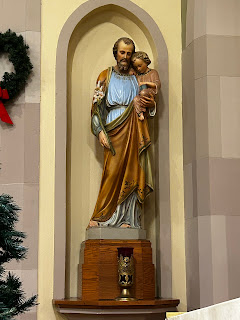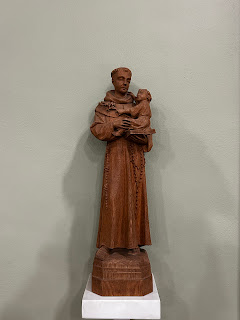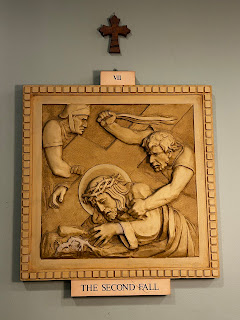Lectio Divina:
Spiritual Reading of the Bible
Jean Khoury
Catholic Truth SocietyISBN 9781860823596
eISBN 9781784693572
ASIN B073FHXFCS
CTS Booklet SP11
Over the last several years, I have read many books from the Catholic Truth Society, over 430 of them in fact. Most were good reads; some were great reads; and a few are exceptional. This is another excellent offering, as are the others in this series I have read. It is the fourteenth in the Deeper Christianity Series that I have read, many of them have been read twice, and this was the first volume from Father Jean Khoury’s pen that I have read. This series is one of my favourites. This edition was originally published 2006 and is an exact translation of Respirare la Parola and the eBook was released in 2017. The description of this volume is:
“In this booklet Lectio Divina is described in a fresh and practical way, encouraging every Christian to take up the Bible and find in it a true guide for the intellect and for the actions of every day.
Spiritual reading of the bible (Lectio Divina) has a long and eminent tradition in the Church. In this booklet the method is described in a fresh and practical way, encouraging every Christian to take up the Bible and find in it a true guide for the intellect and for the actions of every day. The Deeper Christianity Series delves into the mysteries of Christianity, opening up the spiritual treasures of the Church.”
The chapters in the book are:
Preface
The Basics of Lectio
The Process of Lectio
Around the process of Lectio
Conclusion
About the author we are informed:
“Jean Khoury BSc MA received his Theology degrees from the Teresianum in Rome and from the Institut Catholique of Toulouse. He is a highly respected authority for his work on spiritual life and an international author of several books on spirituality and meditation, as well as many articles and studies on mysticism. Jean lectures and leads retreats worldwide on spiritual life and meditation. He also practices Spiritual Counselling in London.”
I enjoyed this volume very much and was challenged by it. While reading this book I highlighted several passages some of them are:
“This book revolutionises the method as it brings a greater clarity on the subject and proposes a simple but efficient way to listen to God daily. It makes the action of God accessible to everyone and shows that our dialogue with God can be very real. So from the image we may have of a ‘silent-distant-mysterious God’, we are led to a new experience where he speaks to us every day, follows us and transforms our lives.”
“The eternal and uncreated Word became human words to nourish us with his divine life. Like a beautiful stained glass window, the words of the Bible let the light of God shine through and illuminate us.”
“If Scripture is to nurture us, in both soul and spirit, we must be determined to let ourselves be disturbed, converted, jostled and enlightened by what we read, instead of looking for what may comfort us.”
“It is impossible to assert that one should live by blind faith alone, opposing it to the understanding we get from the Word of God. Faith finds its sustenance in God’s Word. If this Word is absent, faith becomes very meagre. Conversely, the Word of God, above all else, can fortify it. Faith is, firstly, the belief in a word that has been given.”
“We need to maintain a living and daily contact with the Word so that it may be active in our lives.”
“One’s faith is directly proportional to one’s contact with the Word of God.”
“Lectio is extremely important for spiritual life. It brings us to realise the deep mystery of our vocation: the incarnation of Christ in our life, in our entire being. We are beings who have been given an intellect, a will and freedom.”
“The Catechism of the Catholic Church reminds us of this: “Seek in reading and you will find in meditating; knock in mental prayer and it will be opened to you by contemplation” (CCC 2654).”
“The aim of lectio, as we are presenting it here, is to listen to Christ, to receive a living and active word every day.”
“The morning is the best time for this because the mind is freer and more vigorous, and the light received will be of use all throughout the day.”
“We begin by invoking the Holy Spirit. A possible prayer would be: ‘Come, Holy Spirit, illuminate me, help me to understand the Word today’.”
“Let us then ask the Lord to tell us what He wants: “Speak, Lord, your servant is listening.” This is the first request and the most important one because the entire evolution of the process of lectio depends on it.”
“We should avoid applying our intellect to the text, as this would be a mistake. We need to be receptive, and that is the most difficult thing to be. Our intellect should not only be silenced but also ‘malleable’ before the text, just like a light-sensitive film, while we wait for a word, a sentence to speak out to us, to imprint itself upon us and come to life, more luminous and more intense than the remainder of the text.”
“We do not accomplish our Christian vocation through the force of our will but rather through the humility of our entreaty.”
“Lectio includes only two requests that bring two respective answers from God. The first request (1) (see diagram below) is: “Lord tell me what you want of me” or “let me see the step to take today”. And the second (2) is: “Lord, give me your Holy Spirit in order to incarnate and realise what you are asking of me”.”
“Indeed, the process of lectio consists neither in studying nor analysing a text, it consists in listening and being receptive to the word.”
“Lectio is a great way for us to be assured that we are doing God’s will. It is a way of verification, a test, a true and practical confirmation of our desire to love God; it tells us where we are in our love for God. Loving God is simply doing his will, and the quest for this will is at the heart of lectio.”
I cannot help but believe that this is a perfect time to read this little volume. The CTY is just publishing a new Lectionary and Missals for the Church in England, Scotland, and Wales. I already have on preorder ‘The CTS New Daily Missal’, and having that new daily missal to apply the method in this volume if exactly what is proscribed. Till it arrives I will be doing it with my readings from the American’s in the USCCB.
I hope those samples above will intrigue you enough to pick up this book and give it a try. I know that some today consider Lectio a dirty word. But after reading this I believe it is a most importantly practice and it is vitally important for deep growth.
Khoury has written numerous books on Lectio Divina, and I believe there is an different version of this volume, Lectio Divina The Method, released in 2002. It is the first in a series. I did a side by side comparison and they are very similar. I just wish the others were available digitally. With a dual form of dyslexia I prefer the eBook so I can change the font and colour f page and font to make reading easier.
This book is one of those ones that I believe we really need today, in our current day and age. We need solid teaching, and spiritual nourishment. I have already read this one and plan to return to it again. This is a wonderful read in an excellent series. The CTS Deeper Christianity Series of books is written in such a way that they can easily be read in any order. Pick and choose the ones that interest you, read them in order, or jump around. I have been blessed by all the book in this series that I have read and can easily recommend this book and the series.
Note: This book is part of a series of reviews: 2025 Catholic Reading Plan! For other reviews of books from the Catholic Truth Society click here.
Books in the Deeper Christianity Series:
7 Gifts of the Holy Spirit
8 Deadly Sins Learning to Defend the Life of Grace
Catholic Architecture
Christian Fasting Disciplining the Body, Awakening the Spirit
Deepening Prayer Life Defined by Prayer
Desire & Delight
Faith, Hope and Love The Theological Virtues
Fruits of the Holy Spirit Living a Happy Life
Icons
Lectio Divina Spiritual Reading of the Bible
Making Sunday Special
Mary in the Liturgy
Mary Mysteries of the Blessed Virgin Mary
Providence and Prayer
Prayer in Sadness and Sorrow
Prudence, Justice, Courage, and Temperance
Purgatory A Mystery of Love
Rediscovering Virtue The Art of Christian Living
Christian Fasting Disciplining the Body, Awakening the Spirit
Deepening Prayer Life Defined by Prayer
Desire & Delight
Faith, Hope and Love The Theological Virtues
Fruits of the Holy Spirit Living a Happy Life
Icons
Lectio Divina Spiritual Reading of the Bible
Making Sunday Special
Mary in the Liturgy
Mary Mysteries of the Blessed Virgin Mary
Providence and Prayer
Prayer in Sadness and Sorrow
Prudence, Justice, Courage, and Temperance
Purgatory A Mystery of Love
Rediscovering Virtue The Art of Christian Living
Spiritual Warfare Fighting the Good Fight
The Call to Evangelise: Founded on loving intimacy with the Lord
The Church's Year Unfolding the Mysteries of Christ
The Name of God The Revelation of the Merciful Presence of God
The Trinity and the Spiritual Life
The Church's Year Unfolding the Mysteries of Christ
The Name of God The Revelation of the Merciful Presence of God
The Trinity and the Spiritual Life
Understanding The Story Of The Bible
Union with God
…
Union with God
…
Books by Fr. Jean Khoury:
A Small Catechism on the Prayer of the Heart
Finished and Unfinished Lectio Divina
God Loves You
Igniting the Fire of Our Faith
Lectio Divina at the School of Mary
Lectio Divina in Daily Life
Lectio Divina, Mary and the Spirit
Lectio Divina, The Method
Luke's Final Pentecost
Mary's Fiery Prayer: Trinity, Altar, Fire and Offering
Praying the Mass
Praying with the Heart: The Little Way to Jesus
Seven Letters from your Angel
Small Catechism on Lectio Divina
Solid Foundations Handbook
The Foundations of Spiritual Life: according to St Teresa of Avila
The Interior Life of Mary in Monsieur Olier's letters
The Spiritual Journey: The Setting for Christian Hope
..




















































